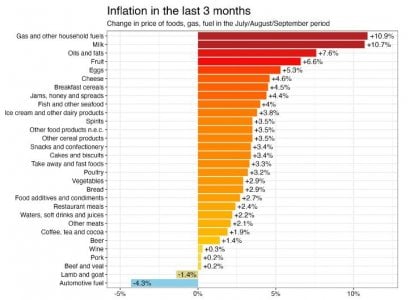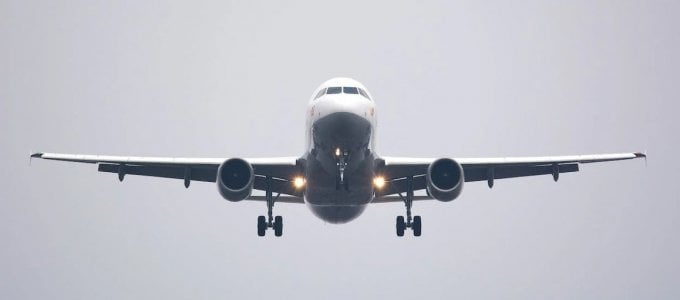Food prices are increasing at an alarming rate! Here's what's changed according to new ABS data
- Replies 3
Here at the Seniors Discount Club, we want to keep you up-to-date with all the latest news, tips and information that could impact your day-to-day lives - especially when it comes to your finances. Times are tough, after all.
That's why we're bringing you this report on the latest Australian Bureau of Statistics (ABS). They recently released the latest data on inflation rates for July, August, and September - and some of the results are shocking. How does that impact me, you may ask? Well, it influences the price of those everyday essentials that you put in your trolley and keep that final total creeping up.
If you're a frugal (read: resourceful) shopper, you know that it's important to keep an eye on inflation rates. This way, you can budget accordingly and be prepared for any hikes in the cost of living.
The newest ABS reports confirm that prices are going up faster than before. The chart below shows some of the key items that have seen big price increases over the last few months, particularly gas and groceries:
Gas prices have skyrocketed in recent months, with many households now paying close to $250 for just two months! And unfortunately, it doesn't look like this trend is going to slow down any time soon.
The cost of food has also been on the rise lately. In the chart above you can see just how many grocery store items have increased in price. Milk now sells anywhere between $1.60 to $3.60 per litre at Woolworths – a hike up from just over $1 per litre.
The cost of fruit and vegetables also dramatically rose in August compared to 2021, according to the ABS.
Meat prices are also starting to creep up which is bad news for summer barbeques. Although lamb and beef didn't see much of a change in this most recent quarter (just fractions of a per cent), their overall prices have still increased.
Recently, the RBA announced that the cost of living is set to rise by as much as 58 per cent next year. You can read more about that report here.
At the very end of the chart is petrol. Fuel prices have dropped steadily throughout July, August, and September.
However, it’s important to remember that this data was taken before the petrol tax was put back on fuel prices in September. Therefore, the next consumer price inflation number will account for the tax back, and the prices of petrol will reflect this change in the official data – that is unless oil suddenly gets cheaper in the coming months.
Other than food and gas, the price of international travel also rose to 10.9 per cent within the last three months. Although most airlines report a shortage of staff and seats, this price increase comes as a shock to frequent flyers.
On the other hand, shoes are getting cheaper based on the chart below:
Shoes are reportedly immune from inflation, and the reason is that they are usually made from synthetic fabrics and not leather. Unfortunately, this doesn’t have a huge change in our daily expenses.
The cost of living in Australia is starting to become a huge burden for some, but some experts say that it’s only going to get worse from here.
Prices of electricity are projected to rise within the next two years, and the recent floods may make this worse. You can read how this can affect your mortgage payments here.

So, what do you think? Which items in your grocery lists have gone up or down the most in price? Share your thoughts with us in the comments section below!
That's why we're bringing you this report on the latest Australian Bureau of Statistics (ABS). They recently released the latest data on inflation rates for July, August, and September - and some of the results are shocking. How does that impact me, you may ask? Well, it influences the price of those everyday essentials that you put in your trolley and keep that final total creeping up.
If you're a frugal (read: resourceful) shopper, you know that it's important to keep an eye on inflation rates. This way, you can budget accordingly and be prepared for any hikes in the cost of living.
The newest ABS reports confirm that prices are going up faster than before. The chart below shows some of the key items that have seen big price increases over the last few months, particularly gas and groceries:
Gas prices have skyrocketed in recent months, with many households now paying close to $250 for just two months! And unfortunately, it doesn't look like this trend is going to slow down any time soon.
The cost of food has also been on the rise lately. In the chart above you can see just how many grocery store items have increased in price. Milk now sells anywhere between $1.60 to $3.60 per litre at Woolworths – a hike up from just over $1 per litre.
The cost of fruit and vegetables also dramatically rose in August compared to 2021, according to the ABS.
Meat prices are also starting to creep up which is bad news for summer barbeques. Although lamb and beef didn't see much of a change in this most recent quarter (just fractions of a per cent), their overall prices have still increased.
Recently, the RBA announced that the cost of living is set to rise by as much as 58 per cent next year. You can read more about that report here.
At the very end of the chart is petrol. Fuel prices have dropped steadily throughout July, August, and September.
However, it’s important to remember that this data was taken before the petrol tax was put back on fuel prices in September. Therefore, the next consumer price inflation number will account for the tax back, and the prices of petrol will reflect this change in the official data – that is unless oil suddenly gets cheaper in the coming months.
Other than food and gas, the price of international travel also rose to 10.9 per cent within the last three months. Although most airlines report a shortage of staff and seats, this price increase comes as a shock to frequent flyers.
On the other hand, shoes are getting cheaper based on the chart below:
Shoes are reportedly immune from inflation, and the reason is that they are usually made from synthetic fabrics and not leather. Unfortunately, this doesn’t have a huge change in our daily expenses.
The cost of living in Australia is starting to become a huge burden for some, but some experts say that it’s only going to get worse from here.
Prices of electricity are projected to rise within the next two years, and the recent floods may make this worse. You can read how this can affect your mortgage payments here.
Key Takeaways
- Inflation is rising rapidly in Australia, with gas and food prices all increasing significantly.
- Travel and meat prices are becoming relatively more expensive.
- Electricity prices are also set to rise 56 per cent over the next two years.










